Your cart is currently empty!
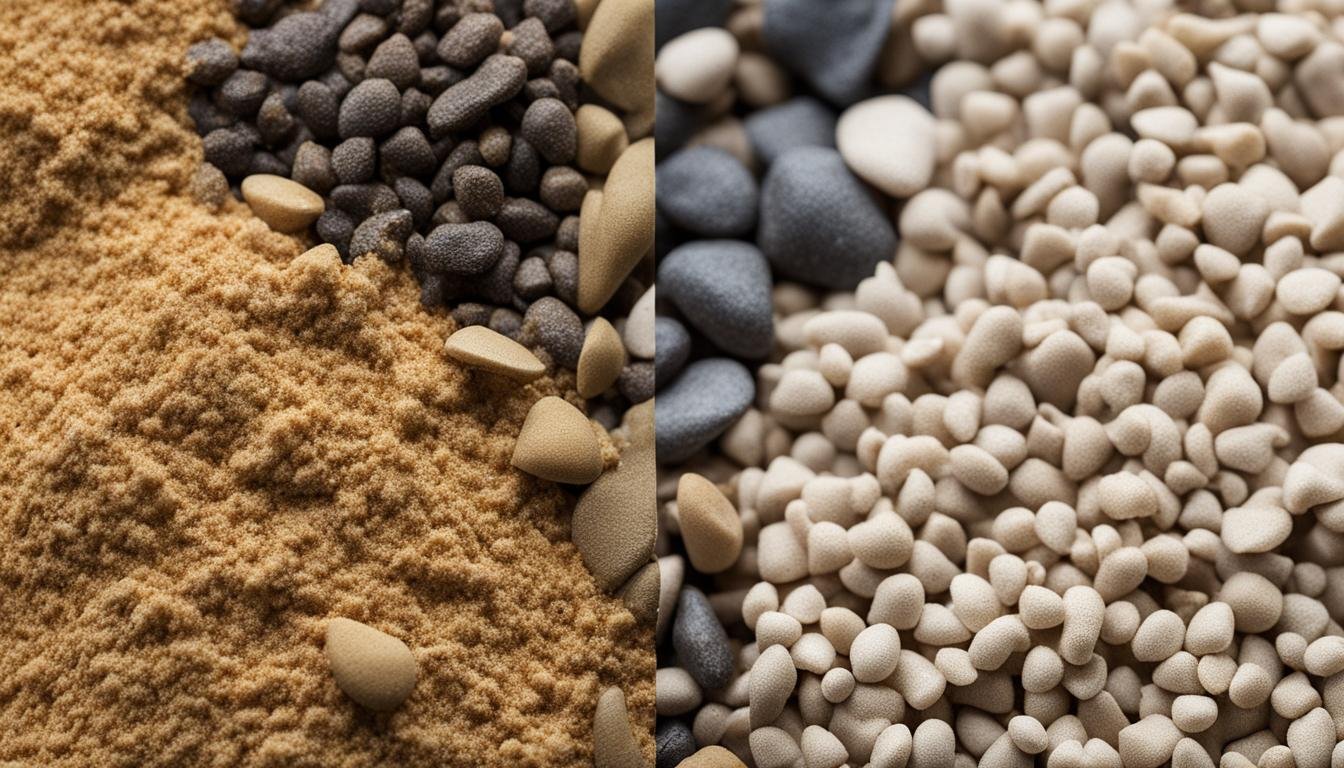
Can Reptile Sand Be Used In Aquariums?
When it comes to choosing the right substrate for your aquarium, there are a few factors to consider. One common question that arises is whether reptile sand can be used in aquariums. In this article, we will explore the pros and cons of using reptile sand and why it may not be the best choice for your aquatic pets.
Reptile sand is primarily designed for use in terrariums and is formulated specifically for desert reptiles. While it may be visually appealing, using reptile sand in aquariums can pose several risks to the health and well-being of your fish.
One of the main concerns with reptile sand is that it may contain bacteria harmful to fish. Unlike aquarium sand, which is designed to be clean and safe for aquatic life, reptile sand can harbor bacteria that can be detrimental to fish health.
Another issue with reptile sand is that the particles may be too large for filter systems in aquariums. This can lead to clogging and reduced efficiency of the filtration system, resulting in poor water quality and potential harm to your fish.
Additionally, reptile sand may contain calcium supplements or compounds that can upset the stomachs of fish. These additives are not suitable for the delicate balance of a freshwater aquarium environment.
While some individuals have reported success with using reptile sand in aquariums, it is generally best to avoid it and opt for aquarium-specific sand that is designed for freshwater tanks. Prioritizing the well-being of your fish and providing them with a substrate that meets their specific needs is essential for creating a healthy and thriving aquarium ecosystem.
Key Takeaways:
- Reptile sand is not recommended for use in aquariums due to potential risks to fish health and water quality.
- It may contain harmful bacteria, particles too large for filter systems, and additives that can upset fish stomachs.
- Aquarium-specific sand designed for freshwater tanks is a safer and more suitable option.
- Prioritize the well-being of your fish and choose a substrate that meets their specific needs.
- Research and consider the requirements of your fish species to create a healthy and successful aquarium setup.
Reptile Sand versus Aquarium Sand
When it comes to choosing the right substrate for your aquarium, understanding the differences between reptile sand and aquarium sand is crucial. While both serve as a base for your tank, they have distinct purposes and compositions.
Reptile Sand
Reptile sand is specifically designed for desert reptiles and may contain additional minerals and compounds that are not suitable for fish. It is coarser in texture and can cause problems in an aquatic environment. The particles may be too large for filter systems, leading to clogs and reduced water flow. Additionally, reptile sand may contain calcium supplements or compounds that can upset the delicate stomachs of fish.
Aquarium Sand
On the other hand, aquarium sand is specially formulated for aquatic environments. It is fine-grained and does not contain additives or harmful compounds. Aquarium sand provides a safe and natural substrate for fish, promoting their well-being and allowing them to exhibit their natural behaviors. It also contributes to a visually appealing underwater landscape.
When deciding between reptile sand and aquarium sand, it is essential to consider the needs of your aquatic pets. While reptile sand may be suitable for reptile habitats, it is not recommended for fish tanks. Opting for aquarium sand designed for freshwater tanks ensures the health and happiness of your fish.
Choosing the Right Substrate for Aquariums

When it comes to creating a thriving aquarium ecosystem, choosing the right substrate is crucial. The substrate not only provides a foundation for your aquatic plants and decorations but also plays a vital role in the health and well-being of your fish. We understand that selecting the perfect substrate can be overwhelming, so we’ve put together some essential factors to consider.
Factors to Consider
- pH Levels: Different fish species thrive in different pH levels. Research the ideal pH range for your fish and choose a substrate that can help maintain those levels.
- Water Hardness: Some fish species prefer soft water, while others thrive in hard water conditions. Consider the water hardness requirements of your fish and select a substrate that can help maintain the appropriate levels.
- Preferred Burrowing Habits: Certain fish species, like bottom-dwellers, enjoy burrowing into the substrate. If you have such fish, choose a fine-grained substrate, like sand, that allows them to exhibit their natural behavior.
By considering these factors, you can ensure that the substrate you choose aligns with the specific needs of your fish and plants, leading to a healthier and more harmonious aquarium environment.
Popular Substrate Options
Now that you understand the importance of choosing the right substrate, let’s explore some popular options:
- Gravel: Gravel is a versatile and widely used substrate option. It comes in various colors and sizes, allowing you to create visually appealing aquarium setups.
- Sand: Sand is an excellent choice for aquariums with bottom-dwelling fish or species that prefer fine-grained substrates. It provides a natural and visually pleasing look.
- Plant-Specific Substrates: If you have live plants in your aquarium, consider using plant-specific substrates. These substrates contain essential nutrients that promote healthy plant growth.
Each substrate option has its own advantages, so choose the one that best suits your aquarium’s needs and aesthetic preferences.
In Summary
Choosing the right substrate is a crucial step in creating a thriving aquarium environment. By considering factors like pH levels, water hardness, and preferred burrowing habits, you can select a substrate that meets the specific needs of your fish and plants. Popular options like gravel, sand, and plant-specific substrates offer a range of choices for creating visually appealing and healthy aquarium setups. So, take your time, do your research, and choose the substrate that will provide the best foundation for your underwater world.
The Benefits of Using Reptile Sand in Aquariums
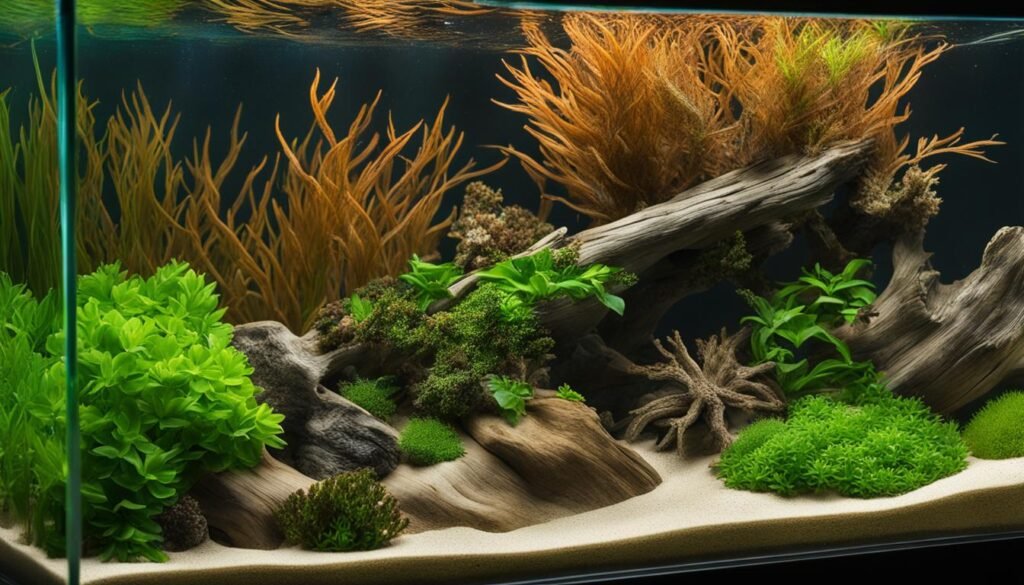
While reptile sand is generally not recommended for use in aquariums, some individuals have reported success with it. Reptile sand can provide a natural and aesthetically pleasing look to the aquarium, enhancing the overall visual appeal. Its fine texture and varying colors can create a visually captivating underwater landscape.
Furthermore, reptile sand can be beneficial for certain fish species that thrive in sandy environments. Bottom-dwelling fish, such as corydoras catfish or loaches, enjoy sifting through the sand substrate in search of food. The sand provides a soft and comfortable surface for these fish to explore and engage in their natural behaviors.
Key Benefits:
- Enhanced aesthetics: Reptile sand can create a visually appealing and natural-looking aquarium environment.
- Comfortable substrate for bottom-dwelling fish: Sand provides a soft and gentle surface for fish to sift through and forage.
However, it is important to exercise caution when using reptile sand in aquariums. Ensure that the sand chosen is safe for fish and does not contain harmful additives or heavy metals. Additionally, proper cleaning and maintenance are necessary to prevent any negative impact on water quality or fish health.
Although some aquarists have successfully used reptile sand in their tanks, it is crucial to consider the well-being and specific requirements of your fish and plants. Prioritize the use of substrates specifically designed for aquariums to maintain a healthy and thriving aquatic environment.
Precautions When Using Reptile Sand in Aquariums
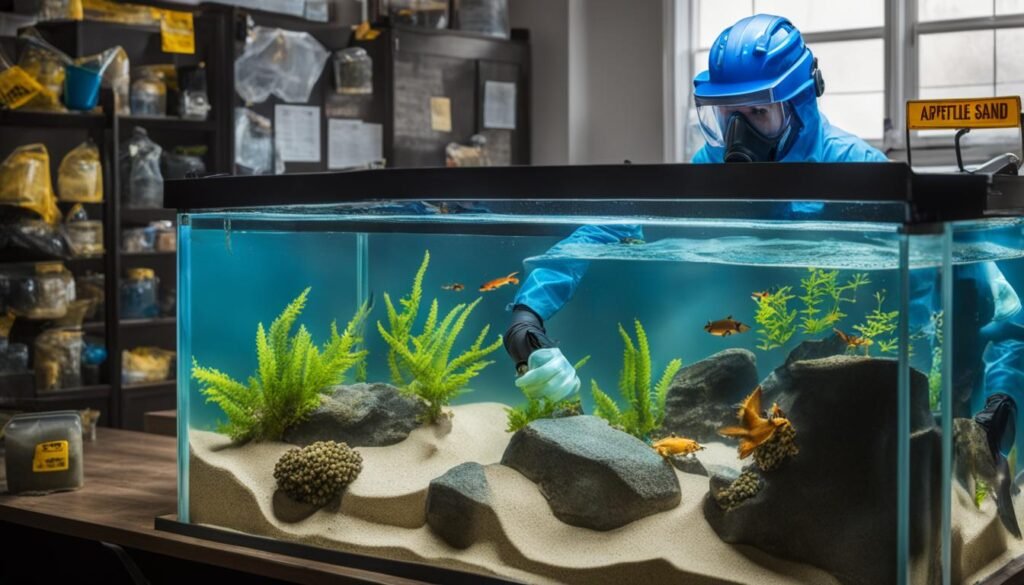
While using reptile sand in aquariums may not be the ideal choice, if you decide to proceed, there are several precautions that need to be taken to ensure the well-being of your fish and the overall health of your aquarium.
- Rinse and clean the reptile sand: Before adding reptile sand to your aquarium, it is crucial to thoroughly rinse and clean it to remove any debris or dust. This will help eliminate any potential contaminants that could harm your fish or affect water quality.
- Monitor water quality: Regularly test and monitor the water parameters in your aquarium when using reptile sand. Look out for any changes or issues that may arise, such as changes in pH levels or water cloudiness. Taking proactive measures can help prevent any negative impacts on your fish’s health.
- Consider compatibility: Not all fish species or plants are compatible with reptile sand. Some may have specific substrate preferences or may be sensitive to certain types of sand. Research the compatibility of the sand with your specific fish and plants to avoid any potential harm.
By following these precautions, you can minimize the risks associated with using reptile sand in aquariums. However, it is important to note that opting for aquarium-specific sand designed for freshwater tanks is generally the safer choice, as it is specifically formulated to meet the needs of aquatic environments and provides a suitable substrate for fish.
Summary
Although using reptile sand in aquariums is not recommended, if you decide to proceed, it is important to take certain precautions. Thoroughly rinse and clean the reptile sand before adding it to the tank, and closely monitor the water quality for any changes. Additionally, consider the compatibility of the sand with your fish and plants to avoid any potential harm. However, choosing aquarium-specific sand designed for freshwater tanks is generally a safer and more reliable option.
Alternative Substrates for Aquariums
When it comes to selecting the right substrate for your aquarium, there are various alternatives to reptile sand that can provide a safe and suitable environment for your fish and plants. Here are some popular options:
Aquarium-Specific Sand
- Designed specifically for aquatic environments.
- Provides a natural appearance and is safe for fish.
- Available in a range of colors and textures to suit your aesthetic preferences.
Gravel
- Offers a variety of sizes and colors, allowing for creative and customizable tank designs.
- Provides a suitable substrate for both fish and plant growth.
- Helps to maintain water circulation and prevent the formation of anaerobic pockets.
Plant-Specific Substrates
- Ideal for aquariums with live plants.
- Contains essential nutrients that promote healthy plant growth.
- Helps to maintain water chemistry and support the root systems of aquatic plants.
When choosing an alternative substrate, it is important to consider the specific needs of your fish and plants. Factors such as pH levels, water hardness, and preferred burrowing habits should be taken into account to ensure a suitable and thriving aquarium ecosystem.
Importance of Proper Substrate for Fish Health

When it comes to creating a healthy and thriving environment for your fish, the substrate in your aquarium plays a vital role. The substrate, whether it’s sand, gravel, or a specialized aquarium substrate, provides a surface for beneficial bacteria to colonize, which helps maintain water quality. It also supports natural behaviors and activities, such as burrowing, foraging, and spawning. Choosing the right substrate that meets the specific needs of your fish species is crucial for their overall health and happiness.
The type of substrate you select can have a significant impact on your fish’s well-being. For example, bottom-dwelling fish, such as corydoras catfish or loaches, prefer soft sand or fine gravel that allows them to sift through for food. On the other hand, fish that prefer open swimming areas, like tetras or guppies, may not have specific substrate requirements. By understanding the natural habitat and behaviors of your fish species, you can choose a suitable substrate that mimics their natural environment and enhances their overall health.
Benefits of a suitable substrate:
- Facilitates the growth of beneficial bacteria, which helps maintain water quality
- Provides a surface for fish to engage in natural behaviors like burrowing and foraging
- Enhances the aesthetic appeal of your aquarium, creating a more visually pleasing environment
- Supports the growth of live plants, if you have a planted aquarium
- Creates a suitable spawning substrate for breeding fish, if desired
By choosing a suitable substrate and maintaining it properly, you can create a healthy and thriving ecosystem for your fish. Regular cleaning and maintenance, such as vacuuming the substrate and performing regular water changes, are essential to ensure the longevity and well-being of your aquarium. Remember to research the specific substrate needs of your fish species and consult with experts or fellow hobbyists to ensure you make the best choice for your aquatic pets.
Tips for Aquascaping with Substrates
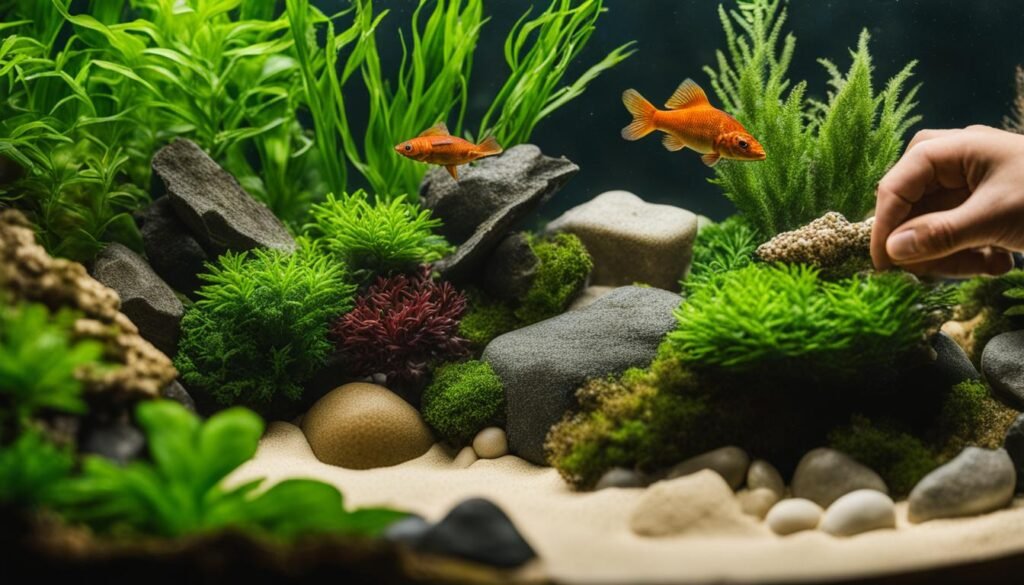
Aquascaping is an art form that allows you to create stunning underwater landscapes in your aquarium. By strategically arranging plants, rocks, and other elements, you can design a visually appealing and natural-looking environment for your fish. When it comes to aquascaping with substrates, there are a few tips to keep in mind.
1. Choose the right substrate
The first step in aquascaping is selecting the right substrate for your aquarium. There are various options available, including gravel, sand, and specialized plant substrates. Consider the needs of your aquatic plants and the fish species you have to determine the best substrate type. Gravel is versatile and provides excellent water circulation, while sand is ideal for bottom-dwelling fish like corydoras catfish.
2. Create depth and texture
Adding depth and texture to your aquascape can make it more visually appealing. Use a combination of substrate sizes and colors to mimic natural underwater landscapes. Place larger gravel or stones toward the back of the aquarium to create a sense of depth, and use smaller pebbles or sand in the foreground for added texture. This layering technique can give your aquascape a more realistic look.
3. Consider plant placement
If you have live plants in your aquarium, their placement is crucial for the overall aesthetic and functionality of your aquascape. Plant taller species toward the back and shorter ones toward the front to create an illusion of depth. Be mindful of their lighting needs and growth habits when arranging them. Some plants may require a nutrient-rich substrate, so consider using specialized plant substrates or root tabs to provide essential nutrients.
4. Pay attention to fish behavior
Observing the behavior of your fish is essential when designing an aquascape. Some fish species prefer open swimming areas, while others seek shelter and hiding spots. Incorporate caves, rocks, or driftwood into your aquascape to provide hiding places for shy or territorial fish. Additionally, consider the fish’s natural habitat and replicate it as closely as possible to create a stress-free environment for them.
Incorporating these tips into your aquascaping endeavors can help you create a visually stunning and harmonious underwater world for your fish. Remember to research the specific needs of your aquatic pets and experiment with different substrate materials and arrangements to achieve the desired effect. Happy aquascaping!
Types of Substrates for Specific Fish Species

When it comes to choosing the right substrate for your aquarium, it’s important to consider the specific needs of your fish species. Different fish have different preferences when it comes to the type of substrate they prefer.
For bottom-dwelling fish species like corydoras catfish or loaches, it’s best to provide a soft sand or fine gravel substrate. This allows them to sift through the substrate in search of food and mimics their natural habitat. Sand is particularly popular for these types of fish, as it is gentle on their delicate barbels and allows them to exhibit their natural behaviors.
However, not all fish have specific substrate requirements. If you have fish species that prefer open swimming areas, like tetras or guppies, you have more flexibility in your substrate choice. These fish are not bottom-dwellers and will rarely interact with the substrate. In such cases, you can choose a substrate based on aesthetics and other factors like water chemistry or ease of maintenance.
Key Points:
- Bottom-dwelling fish prefer soft sand or fine gravel substrates
- Sand is a popular choice for bottom-dwelling fish as it mimics their natural habitat
- Fish that prefer open swimming areas have more flexibility in substrate choice
- Consider aesthetics, water chemistry, and ease of maintenance when choosing a substrate for non-bottom-dwelling fish
Maintaining and Cleaning Substrates in Aquariums
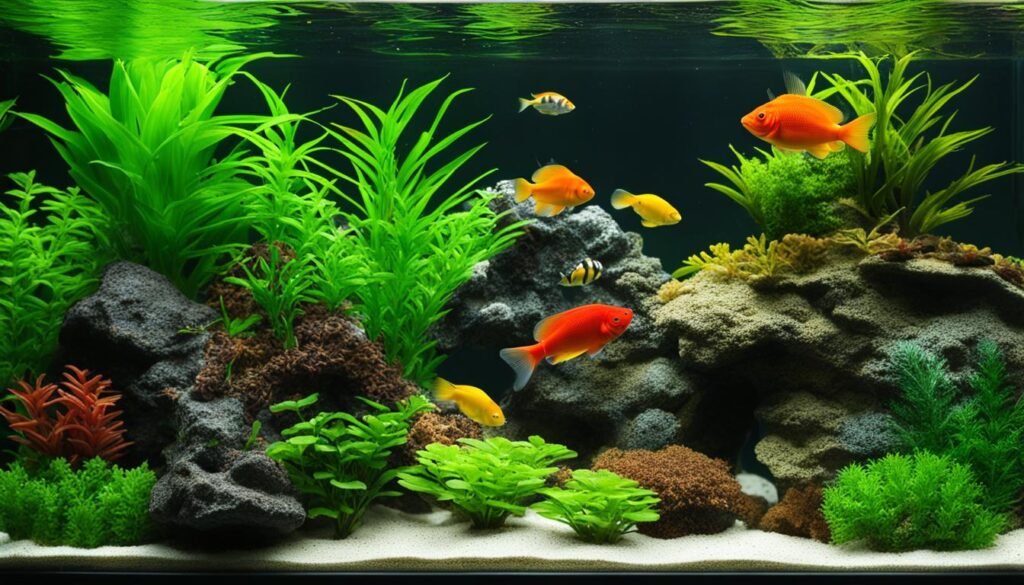
Proper maintenance and cleaning of substrates are essential for the health and cleanliness of your aquarium. Regular care ensures that your fish and plants thrive in a favorable environment. Here are some tips to help you maintain and clean your aquarium substrates:
1. Gravel Vacuuming
Using a gravel vacuum is an effective way to remove debris and waste from your substrate. Start by siphoning the water out of the tank while gently moving the gravel vacuum through the substrate. This will help remove any leftover food, fish waste, or decaying matter that may be trapped in the substrate. Regular gravel vacuuming will prevent the build-up of harmful substances and help maintain water quality.
2. Stirring the Substrate
Stirring the sand or gravel periodically is important to prevent the formation of anaerobic areas in the substrate. Anaerobic pockets can lead to the release of harmful gases and negatively impact the overall water quality. Use a gentle touch when stirring the substrate to avoid disturbing your fish and plants. This will promote better water circulation and prevent the accumulation of unwanted substances.
3. Regular Water Changes
Performing regular water changes is crucial for maintaining a clean and healthy aquarium. When changing the water, be sure to siphon the substrate to remove any debris or waste that may have settled. This will help reduce the accumulation of nutrients and contaminants in the substrate, contributing to better water quality.
By following these simple maintenance routines, you can ensure that your aquarium substrates remain clean and provide a suitable environment for your fish and plants. Regular gravel vacuuming, substrate stirring, and water changes will help maintain optimal water quality and support the overall health and well-being of your aquatic pets.
Common Substrate Mistakes to Avoid
When it comes to selecting and maintaining substrates for your aquarium, it’s important to avoid common mistakes that can have negative impacts on fish health and tank cleanliness. Here are some key mistakes to steer clear of:
- Using inappropriate substrates: One of the biggest mistakes is using substrates that are not suitable for the specific needs of your fish and plants. Reptile sand or other types of sand not designed for aquariums may contain harmful bacteria, toxins, or heavy metals that can pose risks to fish health and water quality.
- Failing to clean or rinse substrates: Before adding substrates to your tank, it’s crucial to thoroughly clean and rinse them. This helps remove any debris, dust, or potential contaminants that could harm your fish or affect water parameters. Proper cleaning is essential to maintain a healthy and balanced aquarium environment.
- Ignoring fish and plant requirements: Different fish species and plants have specific substrate preferences based on their natural habitats and behaviors. Failing to consider these requirements can lead to stressed or unhealthy fish. Research the needs of your aquatic pets and choose a substrate that suits their preferences, whether it’s soft sand for bottom-dwelling fish or plant-specific substrates for live plants.
- Overloading the tank with substrate: Another common mistake is adding an excessive amount of substrate to the tank. This can lead to poor water circulation and the formation of anaerobic pockets, which can negatively impact water quality and fish health. Follow recommended guidelines for substrate depth and ensure proper water flow throughout the tank.
By avoiding these substrate mistakes, you can create a healthier and more vibrant aquarium environment for your fish and plants. Remember to research, choose wisely, and prioritize the well-being of your aquatic pets.
Conclusion
In conclusion, after careful consideration of the use of reptile sand in aquariums, we advise against its use. Although reptile sand can provide an attractive visual aesthetic, it poses potential risks to the health and well-being of fish as well as the overall water quality in the aquarium.
Reptile sand may contain particles that are too large for filter systems to effectively handle, leading to a compromised filtration process. Additionally, there is a possibility that reptile sand may harbor harmful bacteria, toxins, or heavy metals that can negatively impact fish health. These factors can disrupt the delicate balance of the aquarium ecosystem.
Therefore, in order to prioritize the safety and thriving environment of your aquatic pets, it is best to opt for substrates specifically designed for aquarium use. By choosing substrates that meet the specific needs of your fish and plants, you can ensure a healthier and more successful aquarium setup.
FAQ
Can reptile sand be used in aquariums?
No, reptile sand is not recommended for use in fish tanks. It can contain harmful bacteria and particles that may be too large for filter systems. It can also upset the stomachs of fish.
What is the difference between reptile sand and aquarium sand?
Reptile sand is designed for desert reptiles and may contain additional minerals and compounds that are not suitable for fish. Aquarium sand is specifically formulated for aquatic environments and provides a safe substrate for fish.
How do I choose the right substrate for my aquarium?
Consider factors such as pH levels, water hardness, and the preferred burrowing habits of your fish. Some popular options for aquarium substrates include gravel, sand, and plant-specific substrates.
What are the benefits of using reptile sand in aquariums?
While not recommended, some individuals have successfully used reptile sand in aquariums for its natural and aesthetically pleasing look. However, it is important to choose a reptile sand that is safe for fish and does not contain harmful additives or heavy metals.
What precautions should I take when using reptile sand in my aquarium?
Thoroughly rinse and clean the reptile sand before adding it to the tank. Monitor water quality regularly to check for any changes or issues. Consider the compatibility of the sand with the specific needs of your fish and plants.
Are there alternative substrates I can use for my aquarium?
Yes, there are several alternatives to reptile sand, such as aquarium-specific sand, gravel, and plant-specific substrates. These substrates are designed to be safe for fish and provide specific benefits for different types of aquarium setups.
Why is the proper substrate important for fish health?
The substrate in an aquarium plays a crucial role in the overall health and well-being of the fish. It provides a surface for beneficial bacteria to colonize and helps maintain water quality. The right substrate also supports natural behaviors and activities, such as burrowing or foraging.
Any tips for aquascaping with substrates?
Consider the desired aesthetic, the needs of the plants, and the behavior of the fish when arranging substrates in an aquascape. Experiment with different materials and arrangements to achieve your desired look. Research the specific requirements of your plants and fish for a successful aquascape.
What type of substrate is suitable for specific fish species?
Bottom-dwelling fish, such as corydoras catfish or loaches, prefer soft sand or fine gravel. Fish that prefer open swimming areas, like tetras or guppies, may not have specific substrate requirements. Research the natural habitat and behaviors of your fish species to determine the most suitable substrate.
How do I maintain and clean substrates in my aquarium?
Regularly vacuum the substrate with a gravel vacuum to remove debris and waste. Stir the sand or gravel periodically to prevent the buildup of anaerobic areas and improve water circulation. Regular water changes also contribute to overall cleanliness and water quality within the tank.
What are some common substrate mistakes to avoid?
Avoid using inappropriate substrates, failing to properly clean or rinse substrates, and not considering the specific needs of the fish or plants in terms of substrate type and size. Overloading the tank with an excessive amount of substrate should also be avoided.
Can you use a reptile sand in an aquarium?
No, reptile sand is not recommended for use in aquariums due to potential risks to fish health and water quality. It is best to prioritize the safety and well-being of your aquatic pets and choose substrates specifically designed for aquarium use.
Leave a Reply